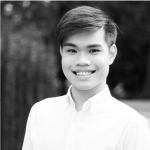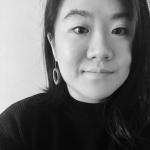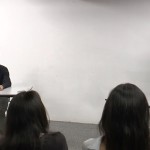
Cheryl introducing the sequel to Poop! by Chong Tze Chien that she and her teammate Isaiah Lee wrote. For this sequel, they had also conceptualised a set to communicate their themes and messages.
“Why is the measure of love loss?” — Jeanette Winterson, Written On the Body
All things amalgamate in Emptiness, to a serene and inevitable futility that awaits our best efforts at understanding and knowing the world in all of its physical and metaphysical, literal and figurative, empirical and conceptual states. Our world exists on its own terms, unconcerned about overwhelm of dichotomous thought and categorisation that ironically both guides and limits our quest for understanding. According to Buddhist philosophy, existence exists in perpetual flux between, above, and beyond states of being and non-being, form and non-form. There is no beginning and no end, no sin and no salvation. There just Is. This is one of the most poignant things I came across in the course of my research on Buddhist philosophy on death and mortality for this residency — the concept of the ineffability of perceiving our world and our immeasurable yet insignificant existence within it according to space and time, the two concepts we have spent centuries constructing instruments and methods with which to measure what we often fail to see is already ironically inherently immeasurable: “Incalculable is the beginning, brethren, of this faring on. The earliest point is not revealed of the running-on, the faring-on, of beings cloaked in ignorance, tied to craving.” (Samyutta 15.1-2). Fearsome and insurmountable is the vastitude of mystery that lies beyond what we think we will ever be capable of understanding, that eludes and slips beyond grasp of even the best of us.
The concept of mortality has haunted humanity through the ages, and throughout all of history we find ourselves trying — oftentimes in vain — to preserve what each age and culture defines as the essence of humanity. Through the ages we have turned to religion, folklore, and mythology, to preserve ourselves and through the stories we tell about the people we love and about ourselves. We find remnants of ourselves scratched on the walls of caves and tombs, in rock sculpted in our own image, in the accounts of sacred texts documenting teachings we have clung onto in man’s search for meaning, in parables that shape who we are and what we believe in. As time as we know and measure it passes, we preserve the worst and best moments of our personal and cultural narratives in photographs, visual art, and oral histories we keep repeating to ourselves, as if repetition solidifies and validates the versions of reality we deem our personal truths. We are obsessed with our own mortality. Perhaps then, it is no wonder that our dead haunt the living: of all the spirits and supernatural beings we fear and believe in and of all the hauntings we ascribe to the dead, the most ultimate and beautifully cruel haunting is in the way we haunt ourselves.
There is a space between the realms of the living and dying that I have been obsessed with since I was a little girl. We segregate the living and the dead too fast too soon. We fear the dead and the afterlife, forgetting that life just marginally precedes death, and being dead is only a different state of being. For most of us, life and death are separated by a world of difference. But how vast, a world!; how vast, the spaces that lie within, that lie between! It is this in-between that with an iron fist grips my intrigue. It is this in-between that I have started to delve into spurred by the research for this residency. Having grown up against a backdrop of loss in which absence is ironically the loudest presence, concepts of grief, death, suicide and all that surround it heavily influence my experience of this world and are spaces that, for better or worse, I may know too much too well. And yet, never fully; never enough.
Death: The Time of Your Life’— this is a title of one of my favourite graphic novels by Neil Gaiman. What is death if not the summation of all our lived experiences, the inevitable conclusion of the time of our lives? What is death if not the end of life? The very simplicity of this thought begs endless interrogation. Firstly, what is an end, and are endings an inherently finite cessation of existence? Are endings and existence truly mutually exclusive? May I suggest: death is a bridge? In the course of my research for this residency I have found myself forced to unlearn everything I know about existence and mortality, all that has been influenced by religion and its affirmation and renunciation, and look at the world like the character of Emily did in Tze Chien’s work — through the lens of unassuming wonder. As children we know how to approach life with wonder and excitement. Along the way, we forget. Revisiting POOP!, identifying a little too well with Emily’s life, and conducting research to write the script for this project reminded me that it is not life that gets complicated as we grow older. It is not true that the more we learn about this world, cruel as it reveals itself to be, the less there is to hope for and to love. It is in the asking of all the wrong questions we demand answers for, in our uncompromisingly held Copernicus complex that we lose our wonder and feel life’s walls closing in on us. If we recklessly abandon ourselves for even just a moment, we realise the world has always been wide enough.

Cheryl’s creative teammate, Isaiah Lee, opening the presentation of Rehearsals for (Im)permanence during the Artist Sharing of The Vault Lite: A Whole New World?
Our initial intention to revisit the absurdism of POOP! through the lens of trauma studies eventually carried us through to the core of what influences Tze Chien’s work — his beliefs and interpretations on Buddhist philosophy and various perspectives on life. What started out as my favourite local play became something more, became a springboard from which I began looking at life in a drastically different way. Because I had not properly engaged with Buddhist philosophy on an academic level prior to this residency, the learning curve was admittedly steep for me. A wealth of information and inspiration was required to be collected and subsequently curated in order to deliver a work in response to not just Tze Chien’s writing but to the very texts he had read at the time of his writing that had inspired it. In engaging with these texts, we found ourselves instinctively returning polarised and dichotomous assumptions about existence and perceptions on the world. These presuppositions and linear modes of thought are scattered everywhere throughout all of history in art, culture, and tradition. Each individual narrative on life and death assumes an inherent dichotomy, a finality, an end. It took us a while to take a step back and see that despite this, all narratives point to something more, much more. Everything I could not find about death and life in the Christian and Catholic teachings I grew up with I began to find in Buddhist philosophy. Everything I knew about looking at the world with polarised perspectives was challenged and subverted. Every utterly inconceivable concept reminded me how the search for answers and reasons will ultimately prove utterly redundant. Strangely, the juxtaposition of an insatiable thirst for understanding and its eventual impossibility has always filled me with hope — there is a beauty in the redundancy and in the futility of the attempt that is at once both humbling and enlightening. The more I research Death, mortality, and the spaces between living and dying, the more I realise how much I have yet to understand about this tragically beautiful and transient world.
The longer I spend embarking on and deeper I dive into this quest to understand death, love, and life through my various art practices, the more I am reminded how much I can understand things without truly understanding anything at all. All the disciplines of art I have done, am doing, and will ever do in this
lifetime merely serve as frames through which I attempt to observe, learn about, make sense of, and speak to the world. And therein lies its fallibility, and the fallibility of all of humanity’s great endeavours — it is inherently limited because I am inherently fallible and limited. As Plath said, “I can never read all the books I want; I can never be all the people I want and live all the lives I want. I can never train myself in all the skills I want. And why do I want? I want to live and feel all the shades, tones and variations of mental and physical experience possible in my life. And I am horribly limited.”. I can never create enough art that will ever adequately explore, understand, or express enough to say I have lived as fully as I want to. If art is language then its essence of expression runs only as deep as the heart and as vast as the soul of its artist.
This residency experience has reframed the way I think about the possibilities of artmaking in Singapore, where everything is measured too much too cautiously. After all, all art is love. In my conversations with Isaiah during the course of this residency and even in our projects outside of this project, this is the one thing we hold on to that grounds us and influences what and why we create. But what if it is not enough? What if love is not enough? And therein lies the paradox — that which governs the space between the living and dying, between love and creation and its inherent futility: it will never be enough.
And yet there is something sacred in the struggle, in the striving and grasping: we can learn to find value in the verb and not the noun. There is something sacred in reaching for what can never be obtained — for a complete understanding of mortality and death; for the creation of art stemming from a place of love that no longer fears if it will ever be enough; for the expression and understanding of the human condition, the concept of which underlies all of art; for the ways by which we measure our lives. It is worth staying where things are undefined, in spaces of formlessness and emptiness — in the spaces between. And at the end of it all, how then would we measure our life? “You lived what anybody gets,” Gaiman writes, “You got a lifetime. No more. No less.”.
Cheryl Charli Tan, Reflections on Rehearsals for (Im)permanence
Rehearsals for (Im)permanence by Cheryl Tan & Isaiah Lee was developed under The Vault Lite: A Whole New World in respond to Chong Tze Chien’s play, POOP!. This edition of The Vault: Lite ran from January to February 2021. Find out more about The Vault: Lite and Cheryl & Isaiah’s work here.





